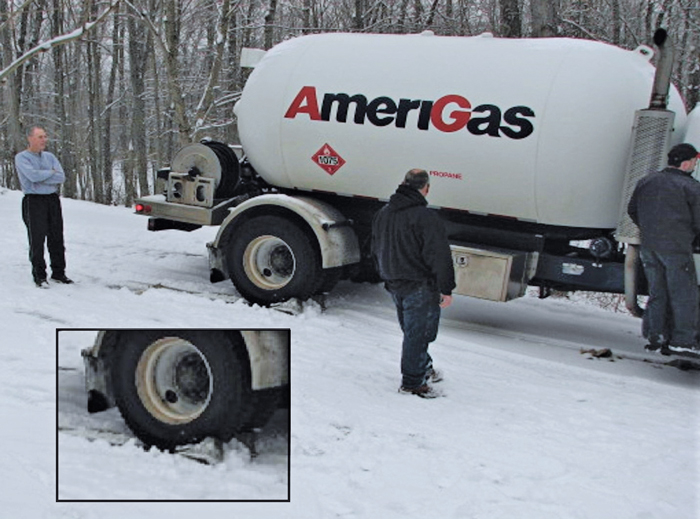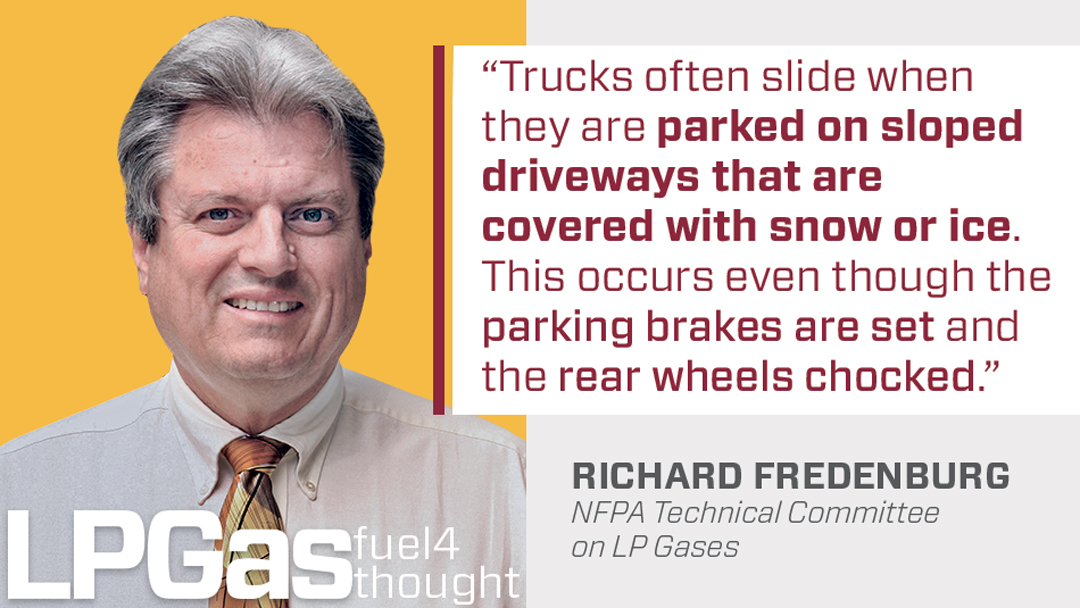Retailer develops new wheel chock policies

AmeriGas Propane tests wheel chock performance under various parking scenarios. Its findings led the company to issue a new chocking policy. (Photo courtesy of AmeriGas)
A sliding truck can cause catastrophic results, including property damage, rollovers, pullaways, product releases, injuries and even death.
These events occur most often when trucks are parked on sloped driveways that are covered with snow or ice. The sliding occurs even though the parking brakes are set and the rear wheels chocked. Normally, these events happen shortly after the PTO is engaged and delivery of fuel begins due to melting and refreezing that occurs under warm tires.
AmeriGas Propane tested this issue and has shared its results to support the industry’s safety efforts.
The photo here shows testing of a truck parked on a hill with the parking brakes set and the rear wheels chocked. Chocking of locked wheels simply pushes the wheel stops ahead, with the tires and chocks sliding in unison. This resulted in a plowing effect, simply pushing up a pile of snow in front of them, as shown in the inset.
To understand the results of the next test, it is important to remember that, when a bobtail is parked for a delivery, it is normally shifted into neutral. When the parking brakes are set, they lock only the rear wheels, not the steer tires. Based on this, testing was next performed by placing chocks under the front steer tires.
This showed that when the wheel stops were placed on the downhill side of the unlocked front wheels, the truck would roll onto the chock. It is important that chocked wheels be able to roll onto wheel stops. This rolling upwards stops the inertia before it can build, allowing gravity to reverse movement, and pushing the chocks into the snow or ice so they can be more effective. In all tests performed with the downhill side of the front tires chocked immediately following initial sliding of the rear tires, the vehicle was effectively immobilized.
The last test that was performed was angling or turning the steer tires to point toward the side of the driveway. This testing showed that when front wheels were not pointing directly down the slope, they also created a plowing effect, like the rear wheels, negating any benefit of the modified chocking method.
There are a variety of reasons that trucks can slide, even when the drive wheels are locked.
- They may have built up some heat while traveling and slightly melt the surface when they stop.
- The vibration from the engine and pump may provide some additional energy for breaking traction.
- The weight compressing the ice may be enough to liquefy the surface as it does for ice skates.
Whatever the mechanism, the trucks moved even when the locked wheels did not turn. They found this also happened on sloped, mud-covered roads.
Based on the results, AmeriGas issued a new chocking policy for various parking scenarios, summarized below:
- Steel or aluminum wheel stops are required, and rubber and wooden chocks are forbidden because they do not grip nor allow for the wheels to roll up.
- Chocks must be set when a vehicle is unattended, loading, unloading, making deliveries or anytime the driver leaves the cab.
- Wheel stops are placed directly forward and behind any one tire when parked on a level surface. (No angled placement of the wheel stops for any scenario.)
- There must be no gap between the tire and wheel stop except when loading the cargo tank, when a small gap is permitted to prevent trapping the wheel stop as the tire compresses.
- Wheel stops are placed on the downhill side of any two wheels when parked on a slope and under normal conditions.
- Wheel stops are placed directly forward and behind one front tire when parked on a level surface and snow or ice is visible.
- Wheel stops are placed on the downhill side of both front wheels when parked on a slope and snow or ice is visible.
- The front wheels must be aimed straight downhill or uphill so they can roll in the direction of travel when snow or ice is visible.
The current LP-Gas Code (2020 edition) requires wheel stops to prevent movement in both directions. It’s unofficial right now, but a revision is in process that will make this company’s improved policy fully compliant.
Wheel stops have been shown to be effective for keeping cargo vehicles from moving inadvertently. Please take a moment to properly deploy them.
Christopher Wagner of AmeriGas Propane assisted with this article.
Richard Fredenburg is an LP gas engineer at the North Carolina Department of Agriculture and Consumer Services, Standards Division. He is also a member of NFPA’s Technical Committee on LP Gases. Contact him at richard.fredenburg@ncagr.gov or 984-236-4752.
NOTE: The opinions and viewpoints expressed herein are solely the author’s and should in no way be interpreted as those of LP Gas magazine or any of its staff members.

















